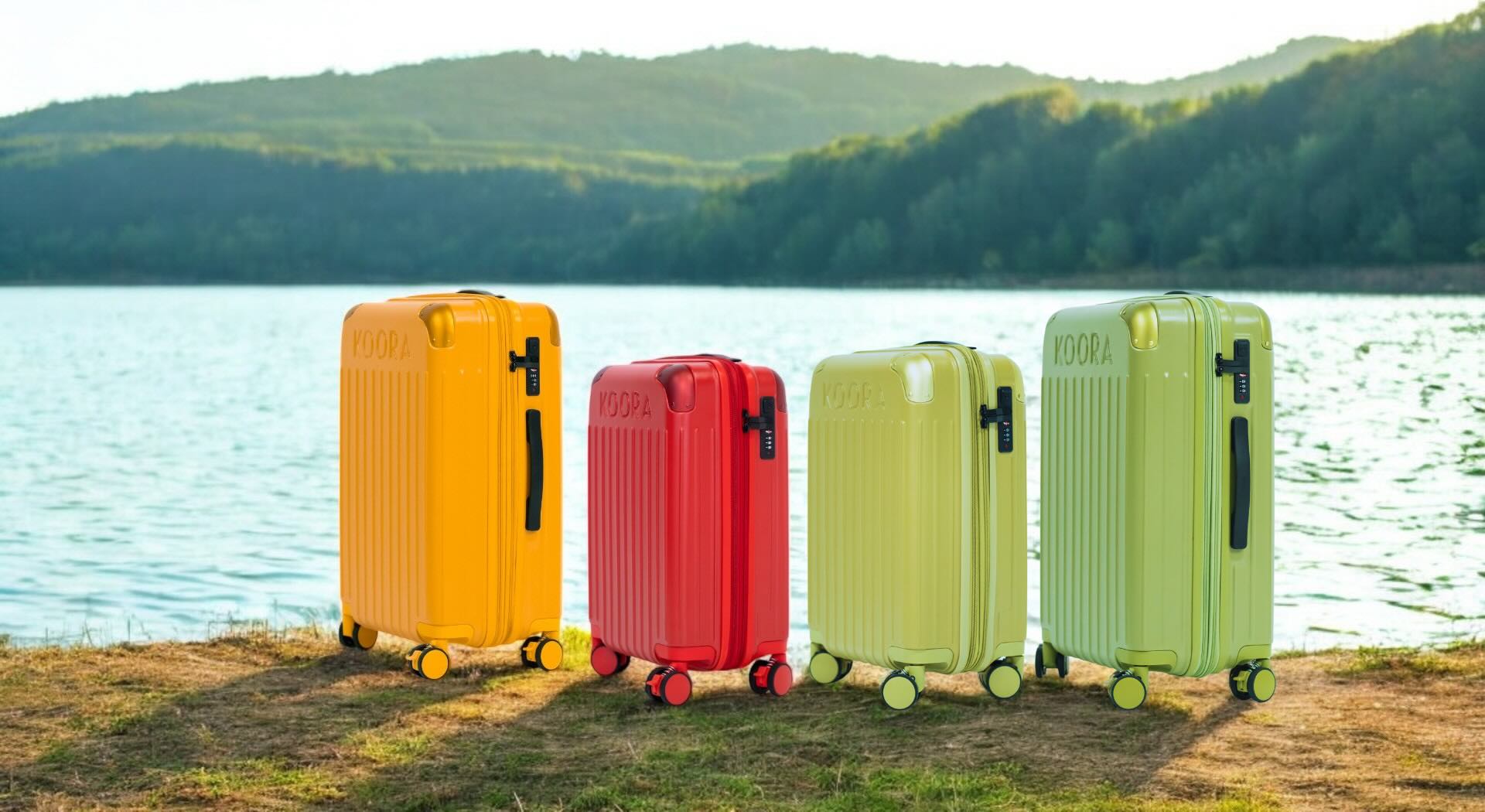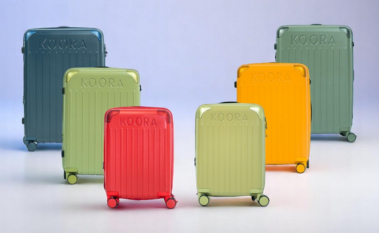
10 Best Eco-Friendly Luggage Brands for Sustainable Travelers in 2025
In an age where all the choices we make leave an ecological imprint, holiday making is no different. From carbon offsetting to toiletries in recyclable packaging, green holidays are on the rise. One of the easiest, but most important changes you can take as a tourist is making luggage choices that have environmental considerations.
Whether you're a traveling digital nomad, a minimalist traveler, or an eco-conscious consumer organizing your next family trip, these are the 10 best eco-friendly luggage brands that are changing the way we travel in 2025.
1. Paravel – Luxury Meets Carbon Neutrality
Paravel is still at the forefront of sustainable travel. Their Aviator collection is the globe's first carbon-neutral suitcase, made of recycled poly-carbonate, aluminium, and vegan leather. The zippers even come from recycled plastic bottles.
Why go for Paravel?
Carbon-neutral manufacturing & shipping
Recycled materials on the inside and outside
Timeless, sophisticated design
Best for: Style-conscious travellers who desire sustainability without sacrificing fashion.
2. Koora – Sustainable Luxury, Crafted for You

A fresh yet powerful entrant from Australia, Koora makes premium luggage from recycled 20-liter plastic bottles and discarded car headlights. Designed for the conscious Gen-Z and millennial traveler, Koora stands out with its clean aesthetics, climate-active goals, and a “Sustainability with ZERO Compromise” mindset.
Noteworthy features:
-
Plant-based lining
-
360° spinner wheels and TSA locks
-
Reforestation and child education with every order
Ideal for: Urban explorers and conscious travelers who believe elegance and ethics can go hand in hand.
3. Monos – Mindful Travel in Minimalist Form
Monos has built a strong following for its minimalist design and transparent manufacturing. Their suitcases are made from aerospace-grade polycarbonate and packaged in recyclable, toxin-free materials. Monos also partners with climate-focused nonprofits for meaningful carbon offsets.
Highlights:
-
Vegan leather details
-
Built-in compression pads
-
Lifetime warranty
Ideal for: Minimalists who value quality, durability, and transparency.
4. Solgaard – Travel Gear That Cleans the Ocean
Solgaard’s Forward Thinking Travel™ line features luggage made from Shore-Tex™ fabric, upcycled from ocean plastic. Each bag removes the equivalent of 5 lbs of waste from marine ecosystems. The award-winning Carry-On Closet even includes a built-in shelving system.
Why it's on this list:
-
Strong mission-led brand
-
Solar-powered backpacks also available
-
Excellent for long trips and organization lovers
Ideal for: Eco-warriors and innovators who crave smart functionality.
5. Samsonite Eco Collection – Big Brand, Bigger Responsibility
Samsonite has leveraged its global scale to introduce lines like the ECO-Nu and Essens Eco, made with post-consumer recycled plastic bottles and eco-conscious dyeing techniques. While not a fully sustainable brand, its strides in product design are worth noting.
Sustainable touches:
-
Global recycling initiatives
-
Recyclex™ material technology
-
Durable, long-lasting designs
Ideal for: Travelers looking for eco options from a trusted global brand.
6. Tropicfeel – Modular Travel Systems with a Purpose
Originally known for their travel shoes, Tropicfeel now makes versatile backpacks and luggage systems designed for modularity. Every product uses recycled nylon and polyester, reducing the need for virgin materials and maximizing utility.
What stands out:
-
Expandable capacity
-
Adaptable for urban, outdoor, and long-haul travel
-
Certified B-Corp
Ideal for: Adventure travelers and backpackers who want performance and purpose.
7. Horizn Studios – Sustainable Meets Smart
Berlin-based Horizn Studios combines tech-forward features with sustainability. Their Circle One luggage is 100% plant-based and biodegradable, while the rest of their range uses recycled polycarbonate and organic cotton interiors.
Tech-savvy & green:
-
Smart chargers available
-
Water-resistant and ultra-light
-
Fully vegan products
Ideal for: Digital nomads and frequent fliers looking for high-tech meets high-ethics.
8. Away (Eco Editions) – Sustainable Capsule Collections
Away, known for revolutionizing the travel luggage market, has introduced limited edition Eco Collections featuring recycled fabrics and carbon offsets. While not entirely sustainable across the board, they are moving in the right direction and have broad appeal.
Eco offerings:
-
Lightweight aluminum and polycarbonate options
-
Internal compression system
-
Strong brand support and customer service
Ideal for: Mainstream travelers seeking gradual eco-transitions.
9. Patagonia Black Hole® Duffels – Indestructible & Recycled
While not a traditional luggage brand, Patagonia’s Black Hole® duffels are built to last decades, made from 100% recycled body fabric, lining, and webbing. Their minimalism, ruggedness, and ethical production practices make them an icon in eco-travel.
Durability meets integrity:
-
Fair Trade Certified™ sewn
-
Extremely versatile — from trekking to airports
-
Repair-friendly brand ethos
Ideal for: Rough travelers, mountaineers, and weekend wanderers.
10. Nere Stori Eco – Bold, Colorful, and Conscious
Nere is gaining traction for its vibrant, bold-colored suitcases that don’t scream “eco” but quietly commit to sustainability. The Stori Eco collection features shells made from 100% recycled polypropylene, and all packaging is 100% recyclable.
Why it makes the cut:
-
Affordable and eco-conscious
-
TSA lock systems and zip compartments
-
Playful designs with a green heart
Ideal for: Young travelers, families, and fashion-forward jet-setters.
Final Thoughts: Travel Light on the Planet
The idea of eco-friendly travel isn’t about giving up comfort—it’s about making smarter choices that align with long-term values. In 2025, these 10 brands are not just keeping up with the sustainability trend—they’re helping lead it.
From fully carbon-neutral innovations to upcycled elegance, the luggage you choose can now tell a story of purpose, innovation, and responsibility.
So next time you’re packing for an adventure, ask yourself:
Am I carrying my values with me?

From Plastic to Purpose: How Recycled Materials Are Transforming Travel Gear
A few years ago, I bought a carry-on that looked great on the outside but cracked after three trips. It was plastic, lightweight, and disposable—just like most of the stuff we unconsciously surround ourselves with. That suitcase ended up in a dumpster. I’ve thought about it ever since.
Now, imagine the same suitcase being made from the trash it would’ve become. That’s the shift we’re witnessing in 2025. Travel gear—yes, your luggage—is getting a soul transplant. What once was plastic waste, beer cans, old car headlights, or abandoned fishing nets is now being reborn as smart, durable, and downright stylish luggage.
And this isn’t a fringe experiment anymore. It’s becoming the new norm.
The Ugly Side of Beautiful Travel
Let’s be honest. We love traveling—new places, new people, that rush of possibility. But the reality is, the travel industry leaves behind a big mess. We don’t just leave footprints on beaches—we leave behind cracked hard-shell suitcases, torn polyester backpacks, and millions of plastic tags, wrappers, and accessories that never decompose.
Traditional luggage, especially the hard-shell type, is typically made using virgin polycarbonate or ABS plastic—materials derived from petroleum. They take hundreds of years to degrade, if at all. Add synthetic linings, zippers, wheels, and chemical-heavy coatings, and you’ve got a suitcase that might outlive you in a landfill.
But something’s changed.
Brands Are Listening—And Creating Differently
What started as a few idealistic brands trying to make a difference has now snowballed into a movement. Luggage manufacturers are turning to recycled and repurposed materials, and what they’re doing is surprisingly... elegant.
Let’s walk through how.
♻️ Plastic Bottles Become Travel Companions
The most common material getting a second life? Your water bottle. Yep. Those transparent, single-use PET bottles that clog rivers and gutters? They’re now being shredded, melted, and spun into fabric—used to line the inside of bags or reinforce outer shells.
Brands like Koora are doing this beautifully. Their bags are made not only from recycled bottles but also incorporate recycled car headlights into the hard shells. Sounds wild, but the result is luggage that feels premium, performs like a tank, and tells a powerful story.
What I personally like is that these bags don’t look like they were made from trash. They're sleek. Minimal. The kind of luggage you’d be proud to roll into a five-star hotel—or toss into the back of a jeep on a road trip.
When Aluminum Gets a Second Life
I never really gave aluminum much thought until I read that it's essentially the recycled material superhero. Unlike plastic, when you use it and reuse it, it doesn't lose its quality. You can melt it, reform it, and it'll work just as well—over and over again.
Now, luggage companies are finally following suit. Rather than using low-cost, fragile plastic components, some are now employing recycled aluminum for frames, handles, and trim. Why the difference? You can tell. These bags are more rugged, cooler to the touch, and possess a certain industrial charm that plastic cannot replicate.
And then there's the experience of having your suitcase burst open after a hard baggage claim toss. Aluminum doesn't roll over that way. It's one of those materials that just seems to be made for the long haul—like your next adventure.
🌊 Plastic That Didn’t Make It to the Ocean
Let me hit you with something unsettling: Every single minute, a garbage truck’s worth of plastic is dumped into the ocean. Think about that. While we sip iced lattes or scroll through flight deals, it’s happening—nonstop.
But here’s the flip side. Some brands are rolling up their sleeves and doing more than just talking about the problem. Solgaard, for example, collects plastic waste from coastal areas—before it ends up drifting into the sea—and turns it into travel gear.
It’s not some gimmick either. Their bags look sharp, last long, and each one removes around five pounds of plastic waste. I remember unboxing one of their products and feeling something odd—relief, maybe? Like, "Okay, I finally bought something that didn’t make the world worse."
Carrying that bag doesn’t just make you feel ready to travel. It makes you feel like you’re part of the clean-up crew—quietly doing your bit without needing a badge or a banner.
🧵 Old Clothes and Fabric Waste, Reimagined
Ever wondered where discarded clothes go? Landfills. But now, old textiles are being turned into recycled polyester and nylon, which make for surprisingly tough and water-resistant materials in backpacks, duffels, and organizers.
Brands like Tropicfeel and Samsonite (Recyclex Collection) are spinning old fabric into new adventures. Literally.
It’s a quiet revolution. No one’s bragging with neon-green “ECO” labels anymore. These bags are stylish first—and sustainable second. That’s the sweet spot.
So... Are These Bags Any Good?
Here’s what I’ve found:
-
They last longer. Recycled materials are often more thoroughly tested for stress, temperature, and wear because they have to prove themselves.
-
They’re lighter. In most cases, recycled plastics weigh less than virgin ones—making them ideal for air travel.
-
They look better. There’s a design minimalism at play here—earthy tones, matte finishes, refined curves. No flashy logos or gimmicks.
Also, many of these brands are transparent about their supply chains, offer repair services, and even accept old bags back for recycling.




Leave a comment
This site is protected by hCaptcha and the hCaptcha Privacy Policy and Terms of Service apply.